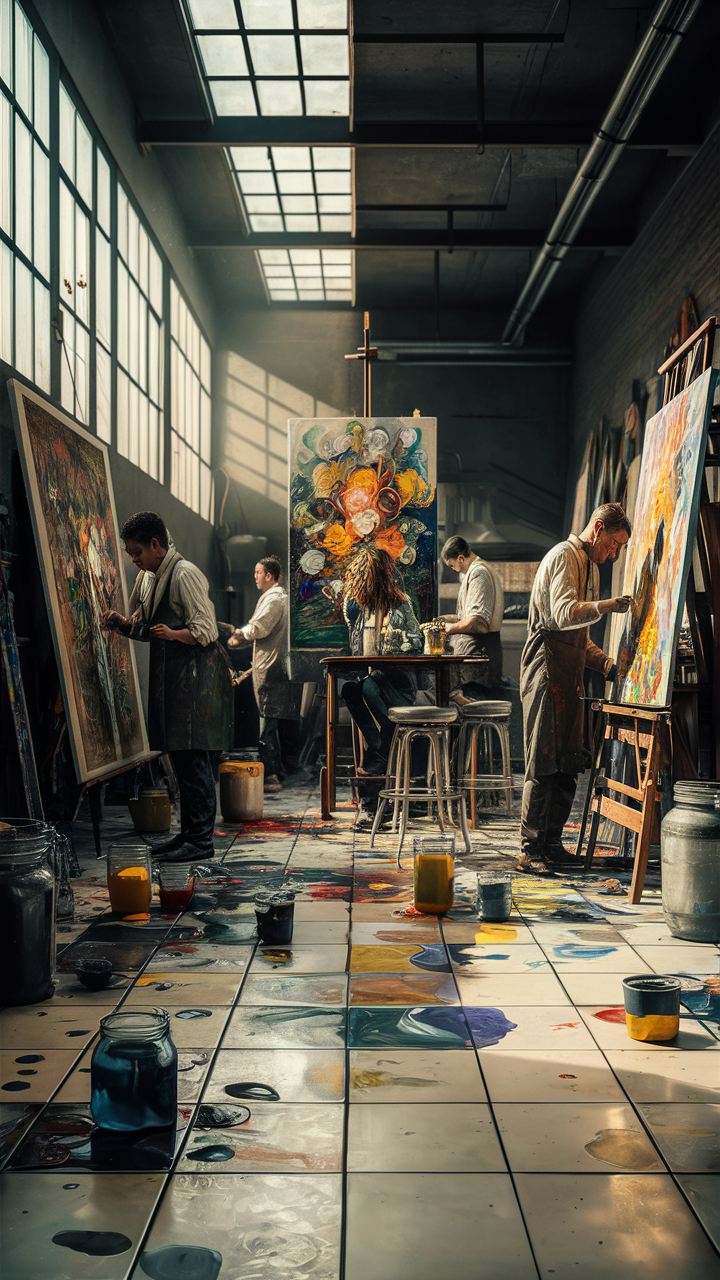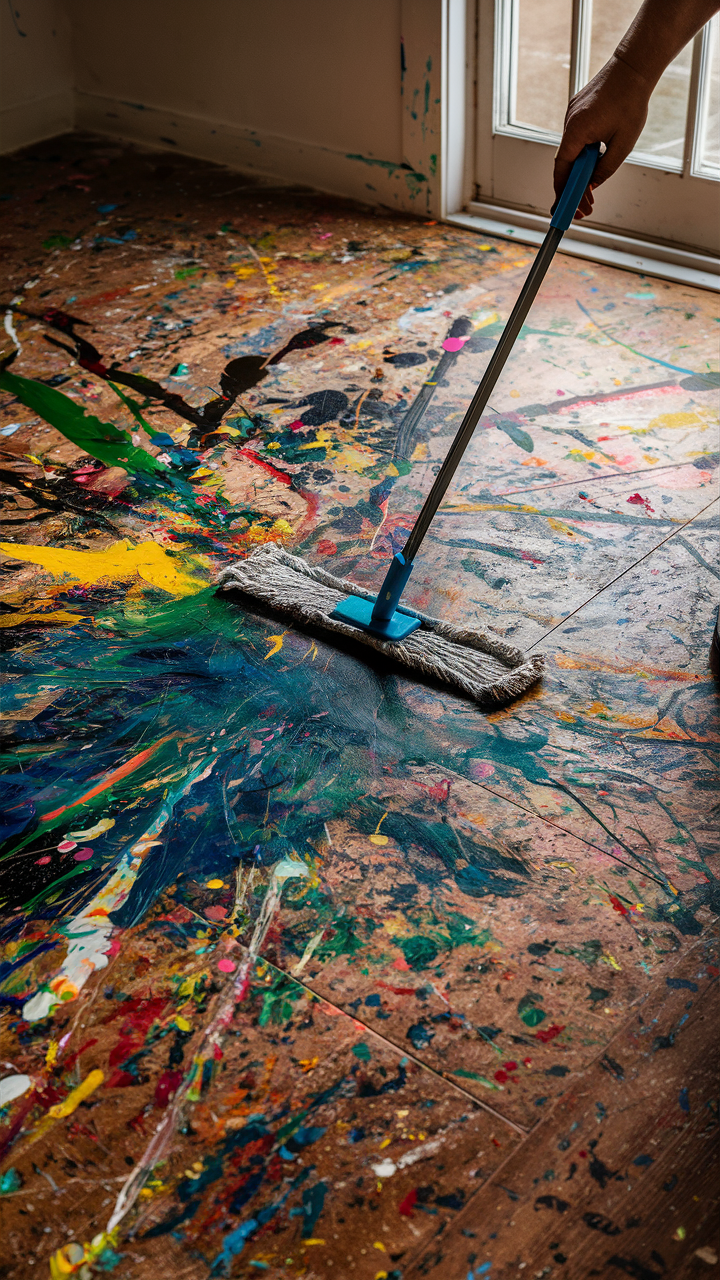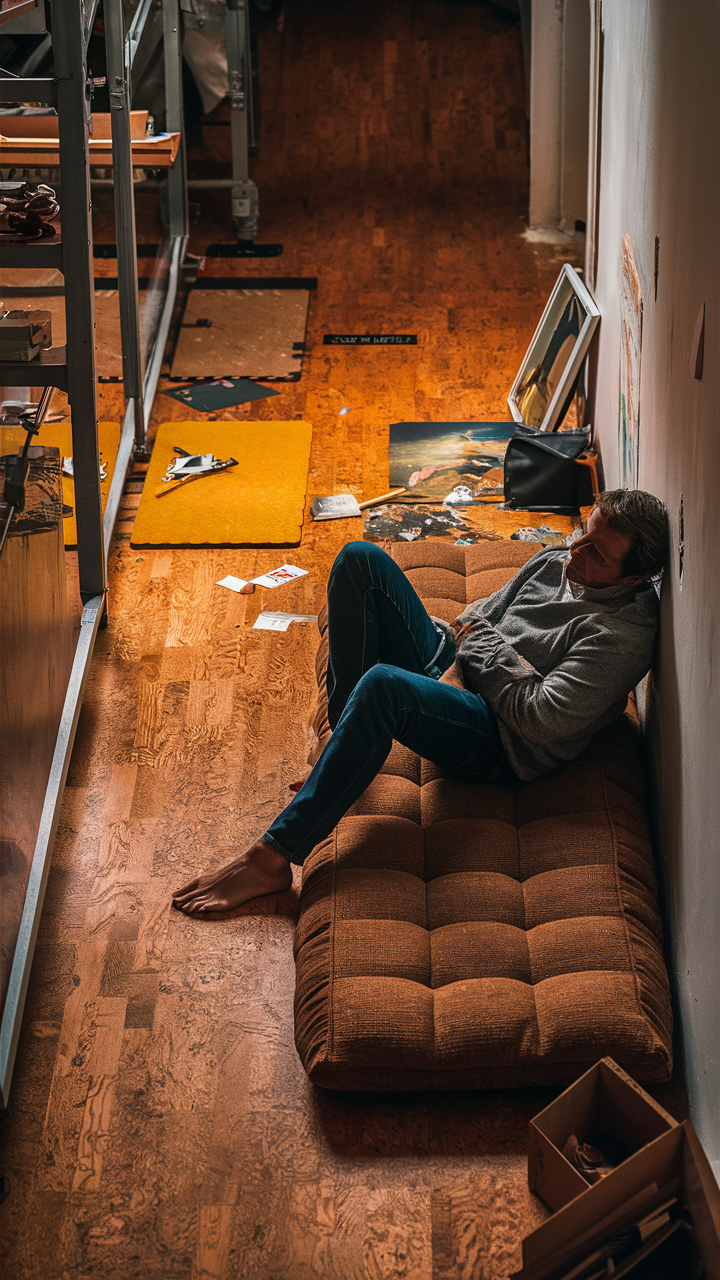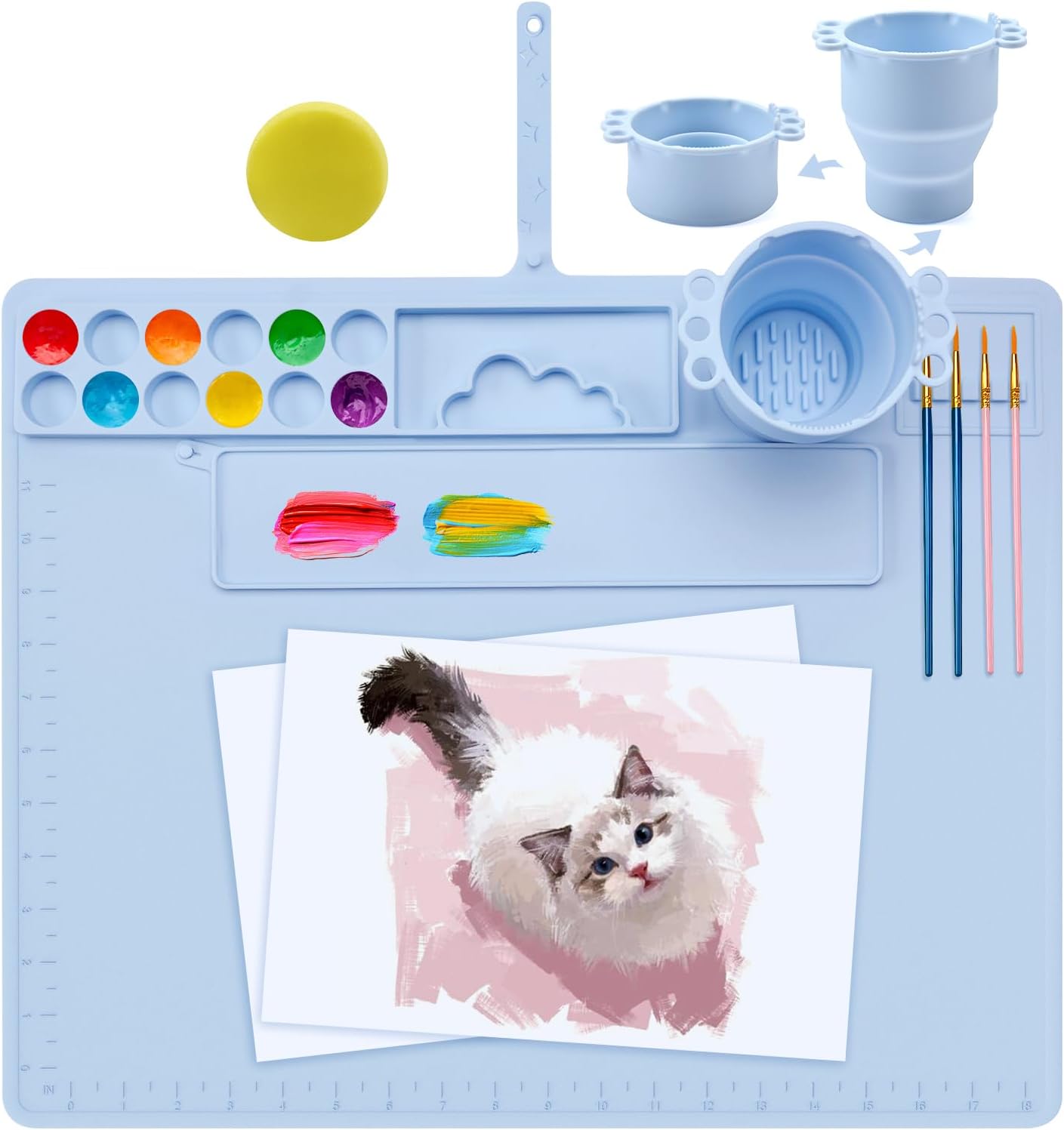Introduction
Ensuring art studio floor protection is key to maintaining both the aesthetics and functionality of your creative space. Whether dealing with acrylic paint spills or the constant traffic of a home studio, choosing the right flooring can make all the difference. Options like vinyl flooring, which is easy to clean, and carpet, known for its comfort, are popular choices among artists. These materials not only protect the underlying surface but also contribute to a conducive working environment.
Selecting floors that combine style and practicality is crucial for any art studio. Waterproof and rubber flooring materials stand out for their durability and ease of maintenance—qualities that every artist values. Moreover, the comfort provided by rubber mats and the visual appeal of tile floors can significantly enhance the workspace, making long hours in the studio more productive and less taxing on the body.
Key Takeaways
- Art studio floor protection is essential for maintaining both aesthetics and functionality in creative spaces.
- Vinyl flooring and carpet are preferred for their ease of cleaning and comfort, making them ideal for studios prone to spills and high traffic.
- Durability and practicality are key; waterproof and rubber flooring offer long-lasting solutions that withstand the rigors of studio use.
- Rubber mats and tile floors enhance both the comfort and visual appeal of art studios, supporting productivity and creative expression.
- Implementing protective measures like drop cloths and area rugs is crucial for safeguarding floors against paint spills and other damages.
- The choice of flooring should align with both the functional needs and the aesthetic values of the art studio, encouraging a blend of style and utility.
Art Studio Flooring Waterproof Protections

Selecting the ideal flooring for an art studio is crucial as it significantly impacts both the functionality of the space and the comfort of the artists. With options ranging from vinyl to foam tiles, each type of flooring offers unique benefits and challenges, particularly in terms of waterproofing and resilience against paint spills. Such choices are essential for maintaining a clean, safe, and inspiring work environment.
Top Waterproof Flooring Options for Art Studios
1. Vinyl Flooring: Renowned for its resilience and ease of maintenance, vinyl flooring stands out as a top choice for art studios. It’s waterproof and offers comfort underfoot, making it suitable for spaces that see a lot of standing and movement.
2. Ceramic and Porcelain Tiles: These tiles are not only stylish but also highly durable and waterproof. They are ideal for areas that require frequent cleaning due to their resistance to water and easy maintenance properties.
3. Poured Resin Flooring: Known for its robust waterproof qualities, poured resin flooring can be customized with colors and effects. It forms a seamless surface that is particularly effective in areas exposed to spills and heavy use.
4. Waterproof Hardwood Options: Innovations like LifeProof Waterproof Hardwood offer the aesthetic appeal of wood with enhanced water resistance. These floors are equipped with protective finishes that shield against moisture and are easy to install.
Each of these options provides unique benefits, ranging from aesthetic appeal to practical maintenance features, ensuring that art studios can maintain a creative yet functional environment.
Types of Flooring Materials
Art studios benefit greatly from flooring materials such as vinyl, laminate, and rubber due to their durability and ease of cleaning. These materials are not only practical but also adaptable to the diverse needs of a creative environment. Vinyl flooring, for instance, offers a layer of protection that is easy to clean, making it a top choice for spaces prone to messes like paint splatters.
Importance of Durability and Comfort
In the dynamic setting of an art studio, the durability of the floor and the comfort it provides are crucial for the well-being and productivity of artists. Materials like foam tiles and cushioned mats are excellent as they reduce fatigue and offer sustained comfort, which is particularly important when artists spend long hours standing. Opting for floors with anti-fatigue benefits helps ensure that creativity is never hampered by physical discomfort.
Home Studio Flooring Solutions for Paint Spills

Dealing with paint spills is a common issue in art studios, which requires flooring that facilitates easy cleanup and maintenance. The right choice of flooring allows artists to focus more on their creativity and less on cleaning up after accidents. This section highlights flooring solutions that are optimal for handling the inevitable paint spills that occur in art studios.
Best Flooring Solutions for Art Studios to Handle Paint Spills
Creating an ideal environment for art creation requires flooring that can handle the inevitable paint spills while still being stylish and functional. Here’s a summarized table of optimal flooring solutions tailored for art studios, highlighting their key features:
| Flooring Type | Advantages | Disadvantages |
|---|---|---|
| Vinyl | Easy to clean, durable, comfortable underfoot | Can be cold, add rugs for warmth |
| Ceramic & Porcelain Tiles | Highly water-resistant, durable, stylish | Hard surface, may be cold |
| Poured Resin | Customizable, seamless, very durable | Higher cost, requires professional installation |
| Concrete | Extremely durable, low maintenance, customizable | Hard surface, may be cold |
| Cork | Natural insulator, comfortable to stand on | Higher cost, can be damaged easily |
Vinyl and tile surfaces are favored for their ease of maintenance, which is crucial for quickly addressing paint spills. Poured resin and concrete offer robust waterproof qualities and durability, making them ideal for high-traffic areas in art studios. For a balance of comfort and aesthetics, cork flooring provides natural insulation and a softer surface, which can be beneficial for artists spending long hours on their feet.
Each flooring option comes with its own set of benefits and challenges, so the choice largely depends on your specific needs, the studio’s overall aesthetic, and the type of art being created. These solutions aim to combine practicality with the creative atmosphere of an art studio, ensuring both durability against spills and an environment that inspires creativity.
Easy-to-Clean Tile Surfaces
Vinyl and tile floors are excellent choices for areas prone to paint spills due to their ease of maintenance. These surfaces are easy to clean and prevent paint from seeping in, ensuring quick cleanup without permanent damage. Materials like lino and sealer-coated surfaces also offer added protection, keeping the studio looking pristine with minimal effort.
Protective Measures for Flooring
To further protect studio floors from spills, artists can implement additional protective measures such as using drop cloths and area rugs. These items not only safeguard the flooring from paint but also contribute to the overall aesthetic of the studio. For areas under heavy use, such as beneath easels or workbenches, placing a piece of carpet or tarp can absorb spills and provide an extra layer of protection against stains and damage.
Comfort and Safety in Flooring

Comfort and safety are paramount in maintaining a productive art studio environment. This section explores flooring options designed to provide both cushioning for comfort and safety features to minimize risks. These choices help ensure that artists can work for extended periods without compromising on their well-being or creativity.
Cushioned Flooring Options
Cushioned flooring options such as anti-fatigue mats and cork are vital for artists who spend long hours standing at their easels or workbenches. These materials reduce the stress on legs and backs, helping to prevent fatigue and discomfort. Additionally, options like carpeted area mats can provide a comfortable surface that easily integrates into any studio design, enhancing both comfort and room aesthetics.
Anti-Slip Features
Ensuring the safety of artists, especially in environments where spills can occur, is critical. Flooring with anti-slip features is essential to prevent slips and falls, making the art studio a safer place for creativity. Materials such as textured concrete floors or rubber mats with interlocking capabilities offer robust safety features that not only protect but also endure the demands of an active studio.
“For safety is not a gadget but a state of mind.” – Eleanor Everet, an influential figure in safety culture
Aesthetic Choices for Art Studios

The aesthetic appeal of a studio not only enhances the space but also serves to inspire creativity among artists. This section explores how selecting the right flooring can elevate the visual appeal of an art studio while ensuring practicality. Different flooring options can create an atmosphere that stimulates creativity and reflects the artistic intent of the space.
Stylish yet Functional Flooring
Flooring options like hardwood and linoleum are perfect examples of combining style with functionality. These materials provide a durable surface that withstands the rigors of artistic work while complementing the studio’s visual aesthetics. Furthermore, these floors are easy to clean, making them practical for spaces where paint and materials might frequently spill.
Integrating Art with Function
Customized flooring choices allow art studios to reflect the artist’s personal style through unique designs and patterns. Incorporating elements like variety of wood finishes or colorful adhesive tiles can tie the room’s theme together and enhance the overall workspace. This personalization not only enriches the studio’s environment but also aligns the functional aspects of flooring with artistic expression.
- Removable Foldable Cleaner Cup
- 20"×16" Silicone Art Mat with Palette Lid
- Silicone Craft Mat for Kids Painting Clay Resin Casting Play Doh
- Multi-Purpose Paint Mat
Conclusion
In conclusion, the importance of art studio floor protection cannot be overstated for artists looking to maintain a practical yet aesthetically pleasing workspace. Choosing materials like vinyl flooring, which is easy to clean, and carpet that offers comfort underfoot, provides a solid foundation that supports both the artistic process and the physical space. These choices not only defend against wear and tear but also enhance the studio’s overall environment.
For those who view their studio as a dynamic and evolving workspace, incorporating hardwood floors or carpet tiles can be equally beneficial. Options that are easy to install, such as snap together tiles or adhesive-backed planks, allow for quick updates and adjustments, ensuring the flooring solutions evolve with the artistic and functional needs of the studio. Opting for floors with water resistance and anti-fatigue benefits further ensures a durable and comfortable setting, enabling artists to focus on creativity without concern for the underlying surface.
James Dunnington leads the James Dunnington Collection, featuring five unique blogs: a practical Pet Care Guide, an enlightening Ancient History Blog, a resourceful Home Improvement Guide, a cutting-edge Tech Innovation Guide, and a strategic Online Money Making platform. Each site delivers valuable insights designed to empower and inform. For updates and more tips, visit our Contact Us page to sign up for our newsletter, ensuring you never miss out on the latest content from any of these dynamic fields.

